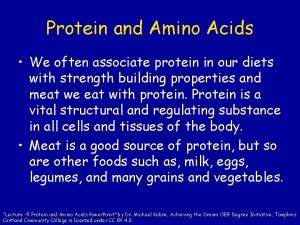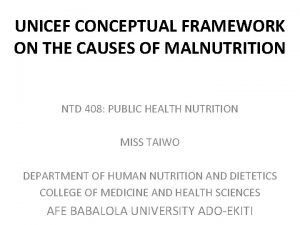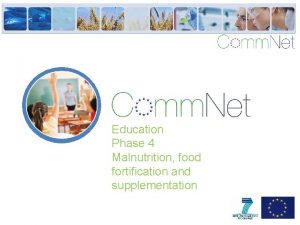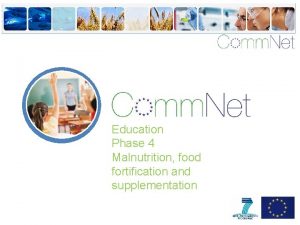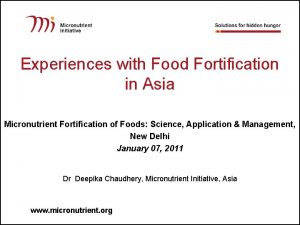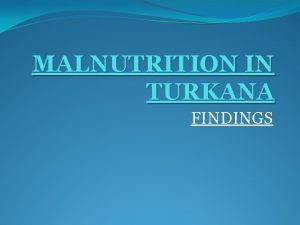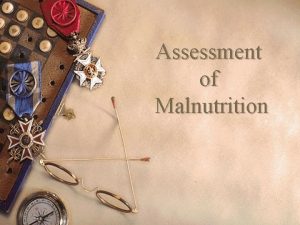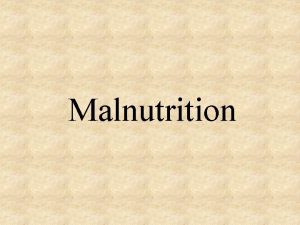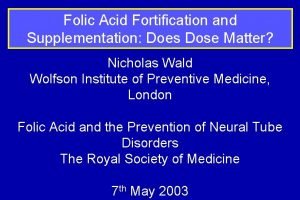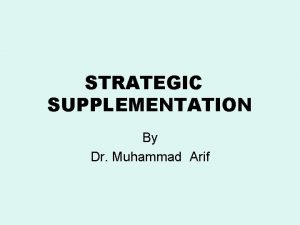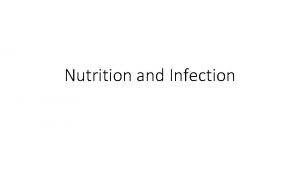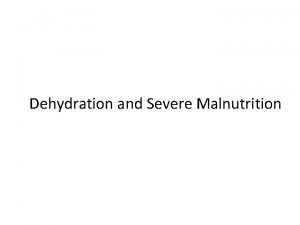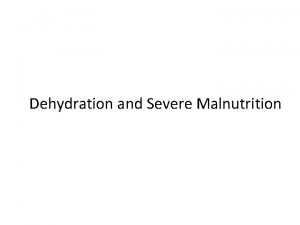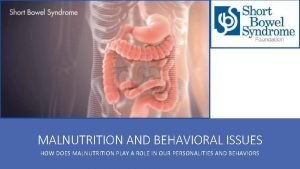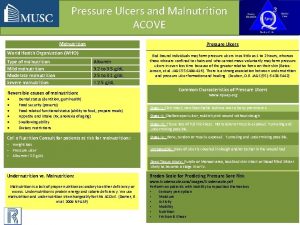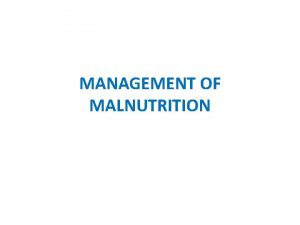Education Phase 4 Malnutrition food fortification and supplementation
















- Slides: 16

Education Phase 4 Malnutrition, food fortification and supplementation

Malnutrition Meeting the body’s needs for energy and nutrients is essential for good health. Intakes of energy and/or nutrients below or in excess of needs over time can affect health and lead to health problems. Malnutrition is a term which covers problems of under nutrition and over nutrition.

Micronutrient deficiencies Malnutrition includes deficiencies in micronutrients, which are nutrients needed in small amounts for many different essential functions in the body. Deficiencies in some micronutrients can lead to disease, for example: • Vitamin D deficiency – rickets (in children) and osteomalacia (in adults); • Vitamin B 12 deficiency – pernicious anaemia; • Vitamin C deficiency – scurvy; • Iron – iron deficiency anaemia; • Iodine – wide spectrum of iodine deficiency disorders (e. g. goiter, endemic congenital hypothyroidism).

What is fortification? Fortification involves the addition of nutrients to foods irrespective of whether or not the nutrients were originally present in the food. The aim of fortification is to help the population achieve the recommended amounts of nutrients. Fortification is often undertaken to address low intakes of a nutrient. Dietary surveys can suggest which groups of the population might benefit from having higher intakes of some nutrients.

Restoration and substitution Nutrients or food components may be added for a variety of reasons: • Restoration – this is where nutrients lost during food processing are replaced. For example, by law in the UK, iron, thiamine and niacin must be added to brown and white flour, as they are removed with the bran during the milling of wheat to make white and brown flour. • Substitution – nutrients are sometimes added to produce a substitute product with similar nutritive value. For example, some soya based drinks sold as a substitute for cow’s milk may have calcium voluntarily added.

Why fortify foods? Adding nutrients to foods, particularly staple foods such as cereals, milk products, sugar, oil and salt, can increase intakes among most of the population. In countries where intakes of certain nutrients are very low, fortification can help to reduce nutrient deficiency diseases. For example, the addition of iodine to salt to decrease iodine deficiency disorders such as goiter. Fortification of some foods may also be seen as providing a marketing advantage, especially where the purchasers have some awareness of the ‘benefits’ of the nutrient being added. This may include adding nutrients to products that would not normally be a natural source, such as adding omega-3 fatty acids to breads and fibre to yogurts. The addition of a nutrient may also offer some technical benefit (for example, vitamin C is an antioxidant and can reduce the rate of spoilage in some products), or a direct health benefit for a subgroup of the population (for example fortification of flour with folic acid to prevent neural-tube defects in babies).

EU Legislation The legislation regarding food fortification in the EU is Regulation (EC) No 1925/2006 on the addition of vitamins and mineral and of certain other substances to food. It applies only to the voluntary fortification of foods, not to foods that are subject to mandatory fortification, and specifies upper safety limits and minimum levels for each nutrient. Vitamins and minerals may not be added to: • unprocessed foods e. g. fruit, vegetables, meat, poultry and fish; • beverages containing more than 1. 2% by volume of alcohol. More information can be found: http: //europa. eu/legislation_summaries/consumers/product_labelling_a nd_packaging/l 21302_en. htm

EU Community Register The EU Community register contains information regarding national provisions on the mandatory addition of vitamins and minerals to foods. The register can be accessed from this page: http: //ec. europa. eu/food/labellingnutrition/vitamins/index_en. htm

UK – Flour fortification Nutrients can be lost during the milling process (e. g. in the production of white and brown flour), the amount being dependent on the quantity of bran and germ removed. However, the UK food industry is required by law to restore nutrients lost through milling. This regulation stipulates the amount of iron, calcium, thiamine and niacin that must be added to all white and brown flour, to restore the nutrients lost in the milling process to levels present in unrefined, wholemeal flours. This ensures that white flour and brown flour contain similar levels of these nutrients to wholegrain flour (which contains the endosperm, germ and bran). Flour fortification means that products made with the fortified flour e. g. bread, will also therefore be fortified.

Certain EU countries – Margarine fortification Margarines have the same amount of total fat as butter, but with less saturated fat. Margarine is defined by law and must contain a minimum of 80%, but less than 90% fat and a maximum of 3% milk fat. It is mandatory to fortify margarine with vitamin A at levels of 800 -1000µg per 100 g and vitamin D at 7. 05 -8. 82µg per 100 g, under UK law. Belgium, Poland Sweden also have legislation requiring the mandatory fortification of margarine with vitamin A and D in various amounts.

Certain EU Countries - Salt fortification Since the 1920 s, some countries have iodized their salt to help prevent against iodine deficiency diseases. The World Health Organisation (WHO) recommends universal salt iodization – the fortification with iodine of all salt used for human and animal consumption – as the main strategy for eliminating iodine deficiency. EU countries which require the mandatory fortification of salt with iodine include Austria, Denmark, Lithuania, Poland Slovenia.

EU - Fortification of breakfast cereals Breakfast cereals are fortified in many countries across the EU, with micronutrients including B vitamins, iron, calcium and vitamin D. This can provide a valuable contribution to the diet of breakfast cereal consumers.

Supplementation Food supplements are concentrated sources of nutrients or other substances with a nutritional or physiological effect, with the purpose of supplementing the normal diet. Food supplements can be in the form of pills, tablets, capsules or liquids in measured doses. Supplements may be taken in order to correct nutritional deficiencies or maintain an adequate intake of certain nutrients. However, in some cases an excessive intake of vitamins and minerals can be harmful to health. Therefore maximum levels are necessary to ensure their safe use in food supplements.

EU Legislation – Supplementation The main EU legislation is Directive 2002/46/EC related to food supplements containing vitamins and minerals. To ensure a high level of protection for consumers and facilitate their choice, the Directive ensures that products put on the market must be safe and bear adequate and appropriate labelling. The Directive sets out labelling requirements and requires that EU-wide maximum and minimum levels are set for each vitamin and mineral added to supplements. More information can be found: http: //ec. europa. eu/food/labellingnutrition/supplements/i ndex_en. htm

Supplementation Different countries have different supplementation policies. UK – Infants and dietary supplementation In the UK, the Department of Health recommend that all children from six months to five years old are given supplements, in the form of vitamin drops, which contain vitamins A, C and D. For growing children, it is sometimes difficult for them to get enough vitamin A and C, especially if their diet is not varied. It is also difficult to get enough vitamin D as there are few food sources and the main source, sunlight, is limited, due to the importance of keeping children’s skin safe in the sun.

Denmark – Pregnancy and dietary supplementation The Danish Health and Medicines Authority recommend that pregnant women take the following supplements: • 400 µg of folic acid a day from when trying to conceive, until week 12 of pregnancy. • 10 µg of vitamin D a day throughout pregnancy. • 40 -50 mg of iron a day from week 10 of your pregnancy. • 500 ml of milk and dairy produce is the best sources of calcium but if a pregnant woman does not eat or drink dairy products, the authority recommends a supplement of 500 mg of calcium a day
 Food delivery fortification
Food delivery fortification Premix for fortification
Premix for fortification Medolac
Medolac General reaction of amino acid metabolism slideshare
General reaction of amino acid metabolism slideshare Mobile phase and stationary phase
Mobile phase and stationary phase What is mobile and stationary phase
What is mobile and stationary phase Detectors used in hplc
Detectors used in hplc Unit 2 food food food
Unit 2 food food food Eltonian pyramid
Eltonian pyramid Normal phase vs reverse phase chromatography
Normal phase vs reverse phase chromatography Tswett pronunciation
Tswett pronunciation Normal phase vs reverse phase chromatography
Normal phase vs reverse phase chromatography Phase to phase voltage
Phase to phase voltage In a ∆-connected source feeding a y-connected load
In a ∆-connected source feeding a y-connected load Csce 441
Csce 441 Maternal and child malnutrition
Maternal and child malnutrition Conceptual framework of malnutrition
Conceptual framework of malnutrition



